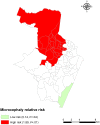Geography of Microcephaly in the Zika Era: A Study of Newborn Distribution and Socio-environmental Indicators in Recife, Brazil, 2015-2016
- PMID: 29920225
- PMCID: PMC6055288
- DOI: 10.1177/0033354918777256
Geography of Microcephaly in the Zika Era: A Study of Newborn Distribution and Socio-environmental Indicators in Recife, Brazil, 2015-2016
Abstract
Objectives: We assessed sociodemographic and health care factors of mothers and newborns during a 2015-2016 outbreak of microcephaly in Recife, Brazil, and we analyzed the spatial distribution and incidence risk of newborns with microcephaly in relation to socio-environmental indicators.
Methods: We collected data from August 2015 through May 2016 from Brazil's Live Birth Information System and Bulletin of Microcephaly Notification, and we geocoded the data by maternal residence. We constructed thematic maps of districts, according to socio-environmental and vector indicators. We identified spatial aggregates of newborns with microcephaly by using the Bernoulli model. We performed logistic regression analyses to compare the incidence risk of microcephaly within socio-environmental indicator groups.
Results: We geocoded 17 990 of 19 554 (92.0%) live births in Recife, of which 202 (1.1%) newborns were classified as having microcephaly, based on a head circumference of ≥2 standard deviations below the mean. Larger proportions of newborns with microcephaly (compared with newborns without microcephaly) were born to mothers who delivered in a public hospital, did not attend college, were aged ≤19, or were black or mixed race. A higher risk of microcephaly (incidence rate ratio [IRR] = 3.90; 95% confidence interval [CI], 1.88-8.06) occurred in districts with the lowest (vs highest) Municipal Human Development Index (ie, an index that assesses longevity, education, and income). The risk of microcephaly was significantly higher where rates of larvae density (IRR = 2.31; 95% CI, 1.19-4.50) and larvae detection (IRR = 2.04; 95% CI, 1.05-4.00) were higher and rates of sewage system (IRR = 2.20; 95% CI, 1.16-4.18) and garbage collection (IRR = 1.96; 95% CI, 0.99-3.88) were lower. Newborns with microcephaly lived predominantly in the poorest areas and in a high-risk cluster (relative risk = 1.89, P = .01) in the north.
Conclusions: The disproportionate incidence of microcephaly in newborns in poor areas of Recife reinforces the need for government and public health authorities to formulate policies that promote social equity and support for families and their children with microcephaly.
Keywords: Zika; ecological studies; environmental indicators; health inequalities; microcephaly; social indicators.
Conflict of interest statement
Figures



Similar articles
-
Mapping the risk of Zika virus infections in pregnant persons and microcephaly in newborns in relation to socioeconomic indicators in Recife, Pernambuco, Brazil: A spatial analysis (2015 to 2021).PLoS Negl Trop Dis. 2025 Jul 9;19(7):e0013240. doi: 10.1371/journal.pntd.0013240. eCollection 2025 Jul. PLoS Negl Trop Dis. 2025. PMID: 40632822 Free PMC article.
-
Microcephaly epidemic related to the Zika virus and living conditions in Recife, Northeast Brazil.BMC Public Health. 2018 Jan 12;18(1):130. doi: 10.1186/s12889-018-5039-z. BMC Public Health. 2018. PMID: 29329574 Free PMC article.
-
Socioeconomic disparities associated with symptomatic Zika virus infections in pregnancy and congenital microcephaly: A spatiotemporal analysis from Goiânia, Brazil (2016 to 2020).PLoS Negl Trop Dis. 2022 Jun 17;16(6):e0010457. doi: 10.1371/journal.pntd.0010457. eCollection 2022 Jun. PLoS Negl Trop Dis. 2022. PMID: 35714146 Free PMC article.
-
Maternal Zika virus infection and newborn microcephaly-an analysis of the epidemiological evidence.Ann Epidemiol. 2018 Feb;28(2):111-118. doi: 10.1016/j.annepidem.2017.11.010. Epub 2017 Dec 14. Ann Epidemiol. 2018. PMID: 29277550 Review.
-
Microcephaly and Zika virus: a clinical and epidemiological analysis of the current outbreak in Brazil.J Pediatr (Rio J). 2016 May-Jun;92(3):230-40. doi: 10.1016/j.jped.2016.02.009. Epub 2016 Apr 15. J Pediatr (Rio J). 2016. PMID: 27049675 Review.
Cited by
-
Exhaustive TORCH Pathogen Diagnostics Corroborate Zika Virus Etiology of Congenital Malformations in Northeastern Brazil.mSphere. 2018 Aug 8;3(4):e00278-18. doi: 10.1128/mSphere.00278-18. mSphere. 2018. PMID: 30089647 Free PMC article.
-
Zika virus infection as a cause of congenital brain abnormalities and Guillain-Barré syndrome: A living systematic review.F1000Res. 2019 Aug 14;8:1433. doi: 10.12688/f1000research.19918.1. eCollection 2019. F1000Res. 2019. PMID: 31754425 Free PMC article.
-
Late Neurological Consequences of Zika Virus Infection: Risk Factors and Pharmaceutical Approaches.Pharmaceuticals (Basel). 2019 Apr 17;12(2):60. doi: 10.3390/ph12020060. Pharmaceuticals (Basel). 2019. PMID: 30999590 Free PMC article. Review.
-
Congenital Zika syndrome and living conditions in the largest city of northeastern Brazil.BMC Public Health. 2022 Jun 20;22(1):1231. doi: 10.1186/s12889-022-13614-x. BMC Public Health. 2022. PMID: 35725427 Free PMC article.
-
High-Risk Areas for Congenital Zika Syndrome in Rio de Janeiro: Spatial Cluster Detection.Trop Med Infect Dis. 2024 May 7;9(5):105. doi: 10.3390/tropicalmed9050105. Trop Med Infect Dis. 2024. PMID: 38787038 Free PMC article.
References
-
- McNeil DG., Jr Zika: The Emerging Epidemic. New York: WW Norton & Company; 2016.
-
- RECIFE. Secretaria de Saúde. Informe Epidemiológico—Síndrome Congênita associada à Infecção pelo Vírus Zika (SCZ) [Epidemiological report—congenital syndrome associated with Zika virus infection (SCZ)]. 2017. https://cievsrecife.files.wordpress.com/2012/08/boletim-scz-se01-2017.pdf. Accessed May 9, 2018. - PubMed
-
- Nunes ML, Carlini CR, Marinowic D, et al. Microcephaly and Zika virus: a clinical and epidemiological analysis of the current outbreak in Brazil. J Pediatr (Rio J). 2016;92(3):230–240. - PubMed
-
- Schuler-Faccini L, Ribeiro EM, Feitosa IM, et al. Possible association between Zika virus infection and microcephaly—Brazil, 2015. MMWR Morb Mortal Wkly Rep. 2016;65(3):59–62. - PubMed
Publication types
MeSH terms
LinkOut - more resources
Full Text Sources
Other Literature Sources
Medical

